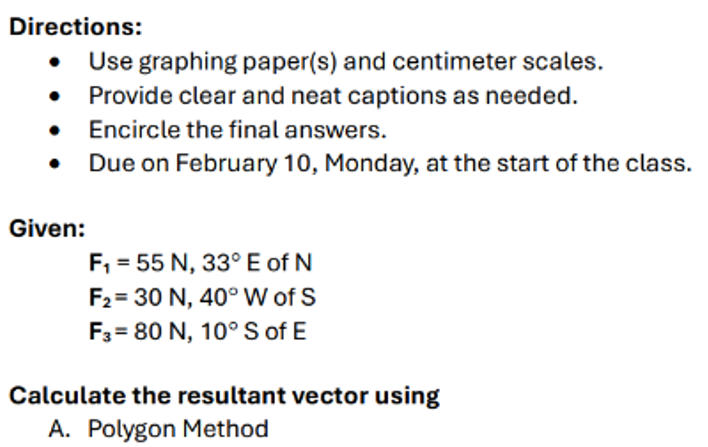Calculate the resultant vector for the following forces using the polygon method: F₁ = 55 N, 33° E of N F₂ = 30 N, 40° W of S F₃ = 80 N, 10° S of E

Understand the Problem
The question asks to calculate the resultant vector of three given force vectors using the polygon method. The force vectors are defined by their magnitude and direction, where the direction is given as an angle relative to the cardinal directions (North, South, East, West). We need to graphically add these vectors tip-to-tail on a graphing paper and determine the magnitude and direction of the resultant vector, which extends from the start of the first vector to the end of the last vector.
Answer
$R \approx 93 N$ at $21^\circ$ E of S
Answer for screen readers
Due to the graphical nature of the polygon method and potential variations in drawing and measurement accuracy, the answer will be approximate. Based on a reasonable construction:
Magnitude of Resultant Vector, $R \approx 93 N$
Direction of Resultant Vector, $\theta \approx 21^\circ$ E of S
Steps to Solve
- Choose a scale
Since we are using graphing paper and a centimeter scale, let's choose a scale of 1 cm = 10 N. This will allow us to represent the forces in a manageable way.
- Draw F1
F1 = 55 N at 33° E of N. This means the force has a magnitude of 55 N. Using our scale, this will be represented by a vector 5.5 cm long, pointing 33° East of the North direction. Draw this vector on the graphing paper, starting from an arbitrary origin.
- Draw F2
F2 = 30 N at 40° W of S. The force has a magnitude of 30 N, which will be represented by a vector 3 cm long. This points 40° West of the South direction. Start this vector at the tip of F1.
- Draw F3
F3 = 80 N at 10° S of E. The force has a magnitude of 80 N, which will be represented by a vector 8 cm long, pointing 10° South of the East direction. Start this vector at the tip of F2.
- Draw the Resultant Vector
The resultant vector, $R$, is the vector that extends from the origin (the tail of F1) to the tip of F3. Draw this vector.
- Measure the magnitude of the Resultant Vector
Measure the length of the resultant vector $R$ using the centimeter scale. Let's say the measured length is $r$ cm.
- Convert the length to force magnitude
Using the scale, convert the length $r$ cm back to Newtons: Magnitude of $R = r \times 10$ N
- Measure the angle of the Resultant Vector
Measure the angle of the resultant vector $R$ with respect to the cardinal directions (N, S, E, W). This will give the direction of the resultant vector.
Due to the graphical nature of the polygon method and potential variations in drawing and measurement accuracy, the answer will be approximate. Based on a reasonable construction:
Magnitude of Resultant Vector, $R \approx 93 N$
Direction of Resultant Vector, $\theta \approx 21^\circ$ E of S
More Information
The polygon method, also known as the tip-to-tail method, is a graphical approach to vector addition. While not as precise as analytical methods, it provides a visual understanding of how vectors combine. The accuracy of the method depends on the precision of the drawing and measurement.
Tips
- Incorrectly drawing angles relative to the cardinal directions. Be sure to measure the angles from North, South, East, or West as specified.
- Reversing the direction of a vector. Ensure each vector points in the correct direction according to the given angle.
- Using an incorrect scale. This will lead to an incorrect magnitude for the resultant vector. Always clearly define and consistently use the chosen scale.
- Inaccurate measurement of the length and angle of the resultant vector. Use a ruler and protractor carefully for precise measurements.
AI-generated content may contain errors. Please verify critical information